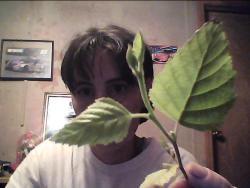hello all, I will tell you I think that elms are the hardest trees to Id, they all look the same most of the time. I took some cuttings and here is a pic of the tip leaves and the terminal bud. it is starting to cool here, it is still very hot, but cool at night, we are going to have an early winter. Anyway the tree was tall and Multi trunk. There were 2 of them side by side at the DR's office. it had new growth and sucker on it. The trunk looked like it was pealing and had a grey, smooth under coat. The leaves vary in size and all. on this twig it is a bit fuzzy and gets fuzzier and greener near the terminal bud. The tops of the leaves are shinny and light green, However this is new growth. looking very closely I can tell that the bottom of the leaves do have fuzz, or hair on it. I have an older one that is a lot greener and it feels kinda silky/slippery compared to the other one, and hit has very hard to see fuzz on the bottom part. This is what is throwing me off though. there are like 3 tiny point on the margin before it hits a vein and and then comes a big point or tooth. Look like a saw blade for sure. but yet other leafs on the same stem are not like that. so Is this an elm? if so or so now? then what is it? Remember that I said it was at the doctor's office so it was in their landscape plan, they did not just grow there on their own, and they were also mulched with pine straw. So here is the pic, remember this is of a brand new one, not and old darker green one and that it is pretty much fall here in Ga.

